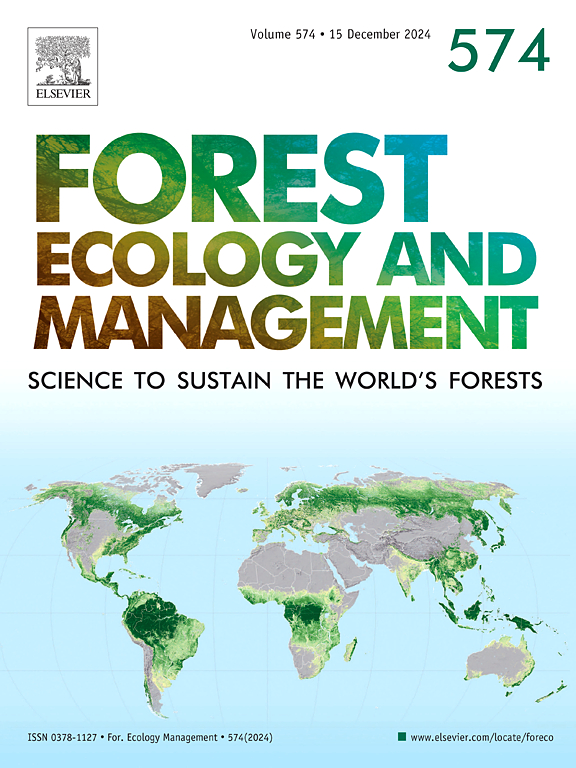干旱可能引发西部云杉芽虫的爆发,但多年来增加的水分供应促进了广泛的落叶
IF 3.7
2区 农林科学
Q1 FORESTRY
引用次数: 0
摘要
西部云杉budworm (christoneura occidentalis)是北美针叶林中分布最广泛的原生落叶虫之一,在生态系统功能的塑造中起着重要作用。在这项研究中,我们使用树木年轮和地理空间数据来重建1650-2023年期间科罗拉多州中部至北部12个地点过去WSB爆发的时期。我们使用这些记录来量化:(1)爆发历史上的时间同步性,(2)欧美殖民前后西部云杉budworm爆发动态的差异,以及(3)气候与爆发开始和停止之间的关系。我们确定了1666年至2023年之间的八个同步爆发时期。在欧美殖民后的最初几十年里,整个研究区域的爆发时间较短,更严重,而且不太同步,这可能是由于1850年至1890年广泛的焚烧导致宿主数量减少。此外,我们发现暴发通常是由干旱事件引发的,并由高于平均水平的水分可用性持续一段时间,这与脉冲应力假设一致。总的来说,我们的工作强调了包括气候和土地利用实践在内的大尺度驱动因素在影响林分扰动过程中的作用。本文章由计算机程序翻译,如有差异,请以英文原文为准。
Drought may initiate western spruce budworm outbreaks, but multi-year periods of increased moisture availability promote widespread defoliation
The western spruce budworm (Choristoneura occidentalis) is one of the most widely distributed native defoliators of coniferous forests in North America, where it plays an important role in shaping ecosystem function. In this study, we use tree-ring and geospatial data to reconstruct periods of past WSB outbreak at 12 sites across central to northern Colorado during the period 1650–2023. We use this record to quantify: (1) temporal synchrony in outbreak history, (2) differences in the dynamics of western spruce budworm outbreaks before and after Euro-American colonization, and (3) the association between climate and outbreak initiation and cessation. We identified eight periods of synchronous outbreak between 1666 and 2023. In the first several decades following Euro-American colonization, outbreaks were shorter, more severe, and less synchronous across the study area, likely due to decreases in host availability that occurred due to widespread burning from 1850 to 1890. In addition, we found outbreaks were often initiated by drought events and sustained by periods of above average moisture availability, consistent with the pulsed stress hypothesis. Collectively, our work highlights the role of broad-scale drivers, including climate and land-use practices, in influencing stand-level disturbance processes.
求助全文
通过发布文献求助,成功后即可免费获取论文全文。
去求助
来源期刊

Forest Ecology and Management
农林科学-林学
CiteScore
7.50
自引率
10.80%
发文量
665
审稿时长
39 days
期刊介绍:
Forest Ecology and Management publishes scientific articles linking forest ecology with forest management, focusing on the application of biological, ecological and social knowledge to the management and conservation of plantations and natural forests. The scope of the journal includes all forest ecosystems of the world.
A peer-review process ensures the quality and international interest of the manuscripts accepted for publication. The journal encourages communication between scientists in disparate fields who share a common interest in ecology and forest management, bridging the gap between research workers and forest managers.
We encourage submission of papers that will have the strongest interest and value to the Journal''s international readership. Some key features of papers with strong interest include:
1. Clear connections between the ecology and management of forests;
2. Novel ideas or approaches to important challenges in forest ecology and management;
3. Studies that address a population of interest beyond the scale of single research sites, Three key points in the design of forest experiments, Forest Ecology and Management 255 (2008) 2022-2023);
4. Review Articles on timely, important topics. Authors are welcome to contact one of the editors to discuss the suitability of a potential review manuscript.
The Journal encourages proposals for special issues examining important areas of forest ecology and management. Potential guest editors should contact any of the Editors to begin discussions about topics, potential papers, and other details.
 求助内容:
求助内容: 应助结果提醒方式:
应助结果提醒方式:


